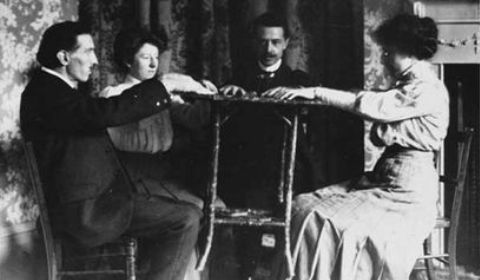In 1999, the horror film The Sixth Sense introduced the iconic phrase, “I see dead people,” into pop culture. The film followed the progression from a young boy’s ability to see the deceased to also hearing what they had to say. In the first decade of the 20th century, this unusual talent would have helped resolve a dispute over the last will and testament of a wealthy estate owner.
In 1906, the estate of Richard R. Rakes was the center of attention for two sets of heirs. The first were the children of Rakes’ first wife, Sarah D. Turner, who passed away several years before. To their dismay, Rakes did not leave them an inheritance because he believed they were already well cared for before his demise. The second set of heirs, however, received a much better report.
The surviving widow, Mary Rakes, and her children were the sole beneficiaries of the estate, which included several hundred acres of property, horses, county bonds, evidence of debts, and other assets worth thousands of dollars. The desires of Richard Rakes seemed fairly straight-forward, if it were not for the betrayal of C. P. Nolen—the executor of the estate.
Nolen decided to partner with the children from Rakes’ first marriage to fool the widow Mary into thinking that a different plan existed.
Their efforts were successful and resulted in Mary filing a lawsuit to reclaim what was rightfully hers. In court, Mary testified that during a visit with children of her husband’s first marriage, she was threatened and then forced to destroy a document she believed to be the will of R. R. Rakes. Mary claimed that C. P. Nolen, husband of Judia Rakes Nolen, vowed to burn down the house that she lived in with her and her children in it, if she did not destroy the document. The jury sympathized with Mary’s plea and discovered that the burned resolution prevailed. End of story. Well, not exactly. A second attempt to thwart Mary’s treasure soon emerged.
R. F. Rakes, a son from the first marriage, filed a $400 counter-suit judgment, which claimed that Mary’s estate included land with a lien of debt. Because the property now belonged to Mary, the lawsuit called for her to account for the debt by either selling or renting the property. In other words, R. F. Rakes believed – If I can’t have it, neither can she!” The judge chose to collect evidence from neighbors to determine the value of the property and how much should be collected from a potential sale or rental agreement. The average value was deemed $6,000, with a $100 to $125 monthly rental fee. When the investigation ended, the jury discovered that Mary had already paid the debt and that she therefore had clear and free ownership of the R. R. Rakes estate.
While there are no extensive details of further challenges, one thing is for certain…all of Mary’s difficulties could have been avoided if the dead could talk.
Mary E. Rakes, widow, etc. vs. W. E. Rakes, etc. and R. F. Rakes vs. Mary E. Rakes, 1906-016, is part of the Patrick County chancery causes.
-Sherri Bagley, Local Records Archivist







